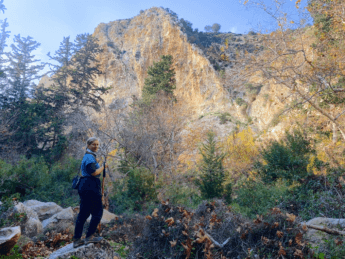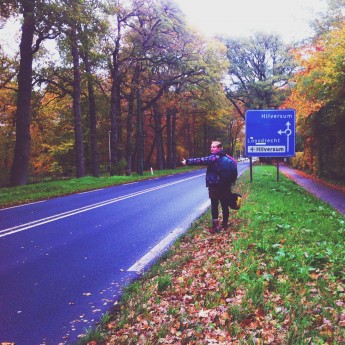
Events from this article happened on Friday the 23rd of August, 2019. We paddled the Danube between Dunabogdány and Budapest in Hungary. Budapest was the original goal of this kayak trip, so it was a big moment for us. The idea was to paddle from Budapest to the Black Sea in 2021 again. Then we decided we could paddle a few hundred kilometers further. Anyway, the total distance of day 42 finally exceeded our previous record of 36.0 kilometers, which makes it the longest paddle day as of yet.
Want to travel the (entire) Danube River in an adventurous way? Join our Facebook group Danube River Source to Sea: Kayak / Canoe / Bike / Hike / Sail to find your community
Dunabogdány – Our Last Stop before Budapest
We stayed in Dunabogdány for two nights in a very large Airbnb apartment. It was a beautiful house and we stayed on the ground floor. There was a garden with lots of flowers and butterflies and behind that the main road through town and the Danube. Our host even provided us a bottle of red Hungarian wine – an incredibly sweet gesture.
Since it’s only 30 kilometers north of Budapest, our guess is that Dunabogdány is the summer house place of well-off Budapesti’s. On our walk to the nearest supermarket, we encountered many people in recreational mode; people running, swimming, biking, and tanning.
‘Road 11’ runs through the village and goes all the way to Budapest. It’s a bit shit to walk there because the sidewalk is definitely an afterthought; it’s too skinny to even fit one wheelchair. Meanwhile, the car traffic from Budapest that’s in a hurry to escape the city speeds on that road that was never meant for anything faster than a horse, really. The constant sound of cars speeding by was also the only thing that made our beautiful butterfly garden a bit less enjoyable.
The problems cars cause in small spaces, terrible infrastructure, and accessibility issues have been on my mind a lot lately. It’s just one of many examples where a product designed for convenience negatively affects everyone and everything until all we have left is the resentment of unfulfilled entitlement. We’ve been promised things we can’t sanely have. If only we could just all take up less space, that would be great.
Leaving Dunabogdány for Budapest
We arose at 6:30, drank a coffee and finished packing. We knew we had to paddle more kilometers than we’d ever done before in one day, but that didn’t worry us. The light flashes and sounds of thunder were the more pressing issue. The luggage first went onto the terrace where we could pick it up without walking under shallow roofs.
We’d promised the old man who owns the Airbnb that we’d leave at 7:30. He came downstairs at exactly that time to hand him back the key. We picked up our luggage from the terrace and waved him goodbye as he opened the fancy gate for us. A thunder cracks somewhere above us, with that specific sound of a whip when it traveled from far away. I count the seconds between flashes and sound and notice it’s only 1.5 kilometers away.
We arrive at the Szentendre branch of the Danube (Szentendrei Duna-ág) at 7:35. The spot is exactly the same as how we left it two days earlier. The water levels didn’t rise or drop. There’s still mud. We’re inflating the boat when we see the arrival of the rain: it disturbs the water first. We flip Zucchini so it doesn’t fill with rainwater and put on our ponchos. That latter move turned out to be a bit of an overreaction, as we sat down on our inflated seats under a tree and didn’t get wet at all.
We waited for the rain to pass and the time between flashes and thunder increase. Then we finished rigging the boat. The dry ponchos went into the CabinMAX. We carried the boat into the water and I expected another slippery mess, but it was alright. We paddled a bit upstream first because we knew it was so shallow around here. Then we turned around and paddled downstream in direction Budapest. It’s 8:15.

Paddling the Szentendre Danube Branch
We’re paddling the shortcut around a very large river island. This branch of the Danube is about 2 kilometers shorter than the main branch where the cruise and cargo ships can still travel. Our river arm is quite skinny and shallow. It reminds us a bit of how the Danube was back in Germany, minus the many weirs we had to portage around. I keep thinking about how I can’t believe this is already our ‘last day’ on the river. Budapest was our goal for this year, and it looks like we’re going to surpass this goal by paddling some more after Hungary’s capital city.
The skies are cloudy as promised. These are pretty good conditions to paddle in for such a long distance. I’m very stoked and nervous at the same time. Stoked because it’s just unbelievable that we’re reaching the goal of this trip today. Nervous because I remember how fast the Danube flowed inside the city of Budapest.


I visited Budapest back in summer 2013 for the first time. I had just turned 22 years old and I really liked to party. After doing so in Budapest, someone I met at the hostel and I went for a slightly hungover hike through the city and we ended up on Margaret Island (Margit-Sziget). We found a small dock there and I took the initiative to seek out the chillness of the water. I jumped in – head underwater – and swum back up to the surface only to see I was at the downstream end of the dock. I’m not a great swimmer, so it took all my power to get back to the dock and not drift away to the Black Sea. The guy gave me a hand to help me out of the water. Back on the shore, I realized this could have been a close call.
So I expected that after the confluence behind the giant Szentendre river island the current would pick up drastically. But here in the branch, there was only a small current. Sometimes there was a promising breeze from the back, but nothing to write home about.
Budapest’s Water Source
We’re calmly paddling on through the river bends as we’ve done on 41 other days. By now, we don’t need any tricks anymore to motivate ourselves to paddle on. We’re familiar with our gear. We have a setup that we’re happy with. There’s not much that we’re learning about our boat or paddling, just the river. And this stretch of the river had always been so far away in our minds.
Both Szentendre Island and the land surrounding it are full of water wells. It provides the (drinking)water of the population of Budapest (1.8 million people) or even metropolitan Budapest (3.3 million people), which makes Budapest also the biggest city on the Danube. The water pressure to rehydrate all those people is immense. We’ve seen the strange structures on the land next to the river. I’m not really sure how they work, but according to the Hungarian translation of Csápos Kút, we’re talking here about a ‘horizontal/angled well‘ type, that is usually used in oil and gas drilling.

Our morning on the Szentendre Danube didn’t announce the appearance of a big city. There were many people doing leisurely activities like kayaking, canoeing, fishing, and speeding with their motorboats, but nothing like the crowdedness of when we paddled from Kelheim to Regensburg on a sunny Thursday. Or perhaps we’ve become desensitized to it. Maybe it’s the fact that the non-motorized boats greatly outnumber the few motorboats compared to Germany. More likely, the fact that there aren’t big ships mixed in with paddleboats really made the difference between us feeling small and helpless or aptly-sized and in control.
We receive a bit of tailwind and I decide at some point that it’s strong enough to use the kayak sail. While it helps us for a few minutes, we change our bearing and the sail starts luffing. I take it down again.

The Villages of Szentendre Island
The first town we passed that morning and the only bridge onto Szentendre Island is Tahitótfalu. Again, like the towns Buda and Pest = Budapest, Tahitótfalu=Tahi+Tótfalu, of which Tótfalu is located on Szentendre island. The bridge that connects the two – called Tildy Híd (Tildy bridge) – is the fifth bridge in this location, constructed in 2007. The locals took the initiative to fund it and charge(d?) a toll to cross it. The previous ones collapsed due to (icy) floods or were destroyed as a scorched-earth strategy in wartime.

After Tahitótfalu, we took a short break on the Szentendre Island from 9:40 till 9:50. We’d covered quite a bit of distance already, but we knew we couldn’t get complacent this early in the day. We continued paddling and saw the landscape change in front of our eyes. A mountain range that started a bit before Tahitótfalu only gave way to more forested hills and mountains. I’ve been claiming that this Pannonian Basin we’re paddling in is flat, but – as always – that’s not the simple truth. I remember reading something before about the Pannonian Island Mountains of prehistoric times and the (current) Transdanubian Mountains.


The first ferry of the day appears: between Leányfalu and Pócsmegyer. There were many announced ferry crossings once again, just like on day 41. What we didn’t anticipate were the small cruise ships that still take this sidearm. They’re very long and skinny boats and remind me of the narrowboats in the British canal system, except these cruise ships are wider. I still don’t fully understand the purpose of these small cruise ships, and whether they’re completely leisurely or basically function as small ferries between Budapest and Visegrád/Nagymaros. The first cruise ship we encountered was actually called the Bogdány – ‘given by god’.



We cross paths with another ferry at Szigetmonostor. I sometimes share a story on Facebook and Instagram of the day while keeping an eye on my phone’s battery. By 10:50, we’re parallel to Pap island, which has a camping and other summer holiday facilities. We didn’t even see the bifurcation this time had we wanted to paddle around it the long way. After the turn, we spot the towers of the town of Szentendre.

The Seven Churches of Szentendre
We’re approaching Szentendre and Jonas is reading me things about the town from his phone. The town of Szentendre is on our right on the mainland, while the island that’s named after the town is on our left. He says something about that the skyline of Szentendre features seven churches. Our slow movement downstream reveals those towers. I grab my big camera to snap a few pictures from the boat while still paying close attention to any boat traffic.
Unfortunately, we won’t make a stop in Szentendre and are unlikely to visit it some other time. Jonas reads me more about the town and how it has been influenced greatly by the Serbians and Croats who settled there in the olden days. Only one of those churches is Roman Catholic, like most of Hungary. The others are mostly Serbian Orthodox. At another point in time, Szentendre was a popular site for artists to cluster. Even from the river, I can see the appeal for the creatively-minded.
But it seems like the overtourism from Budapest has spread here as well. There’s a small quay for those narrow cruise ships to land. I can see a few souvenir shops on the shore and a small crowd of early arrivals. Early? It’s actually 11:00 already when we pass this town. We paddle on.
A Beached Speedboat at Lupa-sziget
Some other paddlers join us on the Danube after Szentendre. Some of them are really fit men in a racing kayak that just paddle up and down the same stretch of river endlessly. With so many encounters, we only greet each other once or not at all.
We pass by some industry that seems to make concrete. The building is also beautifully concrete, so it fits. The river bends left and I’m really feeling on fire now. We’re paddling a distance that’s new to us, but I don’t feel like I need to manage my energy very rigorously, as I seem to have plenty of it. We make a 10-minute break at noon. I tried finding a spot without civilization nearby, but when looking on the map, I see there’s a campsite right behind us in the woods.
We paddle on to the island named Lupa-sziget. We could pass it either on the right where the ferry is or on the left where there’s nothing. I see the big highway bridge behind the island. The night before we left, Jonas and I had discussed which way to take around the island. We’d decided to take the left side. But Jonas is taking a paddling break and we’re drifting to the right arm. A speedboat approaches from the back and zooms into the left arm. Jonas eventually helps me steer into the left arm as well.
Lupa island is a small river island that’s less than 1 kilometer long and about 200 meters wide. There are about 86 houses and it’s only connected by a ferry. It looks really adorable, but it’s very prone to flooding of course. I’m not sure if it would be a good idea to visit since the inaccessibility of the island screams “Leave me alone!”
So we’re next to the island now and see many of the slipways. Every house appears to have its own slipway, which is, of course, smart if you don’t want to rely on the ferry. Then we see the little speedboat that had just overtaken us. The two adults and one child are not in the boat but on the sandy beach of the very small Egyfás-sziget. They didn’t anchor the boat.
Once we’re parallel to the boat, we see that the patriarch is busy talking on the phone, the woman looks defeated, and the child bored. And the boat is beached on the shallow sandbank of the small floodplain-like island.

This solidifies our belief that most people who drive these kinds of motorboats are kind of… immature. We felt sorry for them, but also haha, it sucks to suck.

Rejoining the Danube After Szentendre Island
We duck under the Megyeri híd, also known as the Stephen Colbert híd in a similar event to the open poll crowdsourced name of ‘Boaty McBoatface‘. It’s a pretty impressive cable-stayed bridge with two pylons on the main Danube side. It leans on the southern end of the Szentendre island to eventually reach the mainland again on the other side. It’s Hungary’s longest and most expensive bridge. Despite the fact that it crosses the island, it’s not possible to enter the island from the bridge. This seems like a bit of a missed opportunity (and saving on the wrong end) to me. Here’s a 3D rendering of the bridge and Lupa island in the foreground:
After the bridge, we stuck to the shore of the Szentendre Island in preparation for the confluence with the main Danube again. There was a ferry on the right-hand side that crosses around the southern tip of Szentendre-sziget, but it wasn’t going anywhere. Our main fear was that there would directly be a lot of cargo and cruise traffic after the confluence. And we needed to cross to the left-hand side of the river completely to land at our anticipated spot.


We arrived at the end of Szentendre-sziget at 12:50. At the tip, we encountered another paddler fishing in a canoe in the dead zone where there’s not much current. I expected there to be a lot of currents, but there wasn’t really any change. Had I overestimated the speed of the Danube in Budapest? We weren’t there yet, so it was too soon to tell.

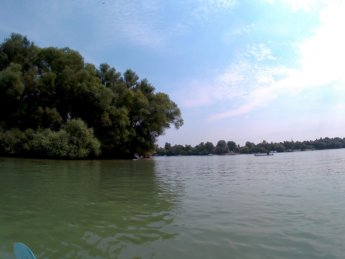
We looked around the corner into the main Danube. There was one cargo ship, but it was traveling away from us. From downstream, nothing came our way. The coast was clear, so we made the effort to cross. There were some buoys to indicate the shipping lane with some resting seagulls on there. We paddled past some moored boats on the left-hand side and concluded our crossing at 13:00.



Entering Budapest City Limits
We’d officially entered the city limits of Budapest now. After the train bridge, we could see the outline of the city clearer and clearer, with the tip of Margaret Island (Margit-sziget) becoming more defined. As we were so far on the left, we totally missed the bifurcation that creates Óbuda Island (Óbudai-sziget) where the annual Sziget Festival is held. Someone held a wedding photoshoot on the left shore while the airplanes from Budapest Airport take off over an uncanny-looking gated community.


The plan was to get next to Margaret Island after ducking under the Árpád bridge and then cross from left to right to land on the island at the kayak club’s pier. From there, we’d be able to see the Hungarian Parliament. If that landing spot didn’t work, there would possibly be stairs just a few hundred meters before the parliament building for us to use.


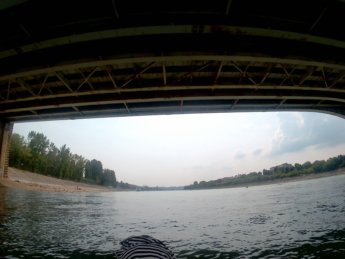
We aren’t pioneers by paddling this stretch of the Danube. While there aren’t (m)any resources in English, it’s been done before. Jonas is a religious follower of the site Flusswandern, which roughly translates to ‘river wandering’. It’s an Austrian resource for paddlers and contains quite some information on the Danube. Steve from Flusswandern clearly says “Keep right of Margit-sziget under any circumstances”. We went left and it turned out not to be a bad decision after all. Jonas’ paddle god is sometimes wrong.
The city of Budapest also has ferries as public transportation. These small ferries take a route up and down, left and right on the Danube to make the Buda and Pest sides a lot more accessible. There are 18 stops and I believe at least two different lines that call different ports.
There were so many of these ferries, that we didn’t cross as early as I wanted. Jonas kept an eye on the ferries from the back, while I gauged the speed of the ferries ahead of us. We even stalled a bit by backpaddling so that we wouldn’t be at one of the many piers while such a ferry started docking. It was quite exhausting to deal with this. Every time we thought of crossing, another ferry would appear and ring its bell in a passive-aggressive manner.
And the ferries weren’t exactly the only traffic. There were still cruise ships of all sizes and a few cargo ships. We eventually crossed to the Margaret Island side and directly got in trouble with a docking ferry. These ferries are highly mobile, so it wasn’t like we were in danger, but it’s like trying to negotiate a right of way with a parent with twins in a stroller in the aisle of a small convenience store: everybody gets irritated.
Arriving on Margaret Island, Budapest
With all the crowdedness, we still managed to paddle the last stretch of Margit-sziget in relative peace. We encountered a very tame stork on the rip rap and spotted the towers of the Hungarian Parliament. This is kind of a big moment.
We saw the outline of the floating docks of the local kayak club. We slowed down to enjoy the last bits. There is absolutely no pressure from ourselves to continue further than Budapest. It’s kind of spectacular to end the trip that started in humble Donaueschingen in a majestic city like Budapest.
We approached the dock, turned our boat around, and landed right there. It’s done!
Jonas got out first. He helped me out and we lifted all the stuff out of Zucchini onto the moveable dock. It was quite high for kayaks and canoes. Then we took Zucchini out of the water and took some photos.
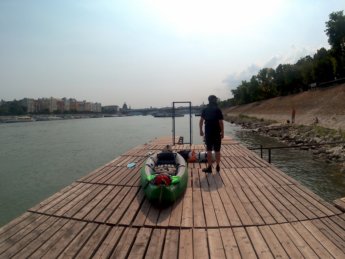


After the photo session, we packed up our things and carried them up the steep shore. This city seems very ready for extreme lows and highs of the river water levels. Up the embankment, I walked around to pick a bar where we could have a wheat beer (búzasör) with our stuff while our boat dries. We picked one very busy place that was convenient but otherwise not our kind of place.
We drank some beers, ate some warm food, and then packed up the boat to take a ferry from the nearby Margaret Island Centenary Monument (Margitsziget Centenáriumi emlékmű) station to the other side at Jászai Mari Square (Jászai Mari tér) station. Jonas bought our tickets on the ferry while I held onto our gear. On the other side, we took a Bolt taxi to our Airbnb.
We’d stay in Budapest for one week and then decided we’d exceed our goal and paddle on to Ercsi, Dunaújváros, Harta, Paks, Érsekcsanád Dunapart, Baja, and finally Mohács. Mohács is the last town on the Hungarian Danube.
Thank You For Reading! Will You Share this Article?




